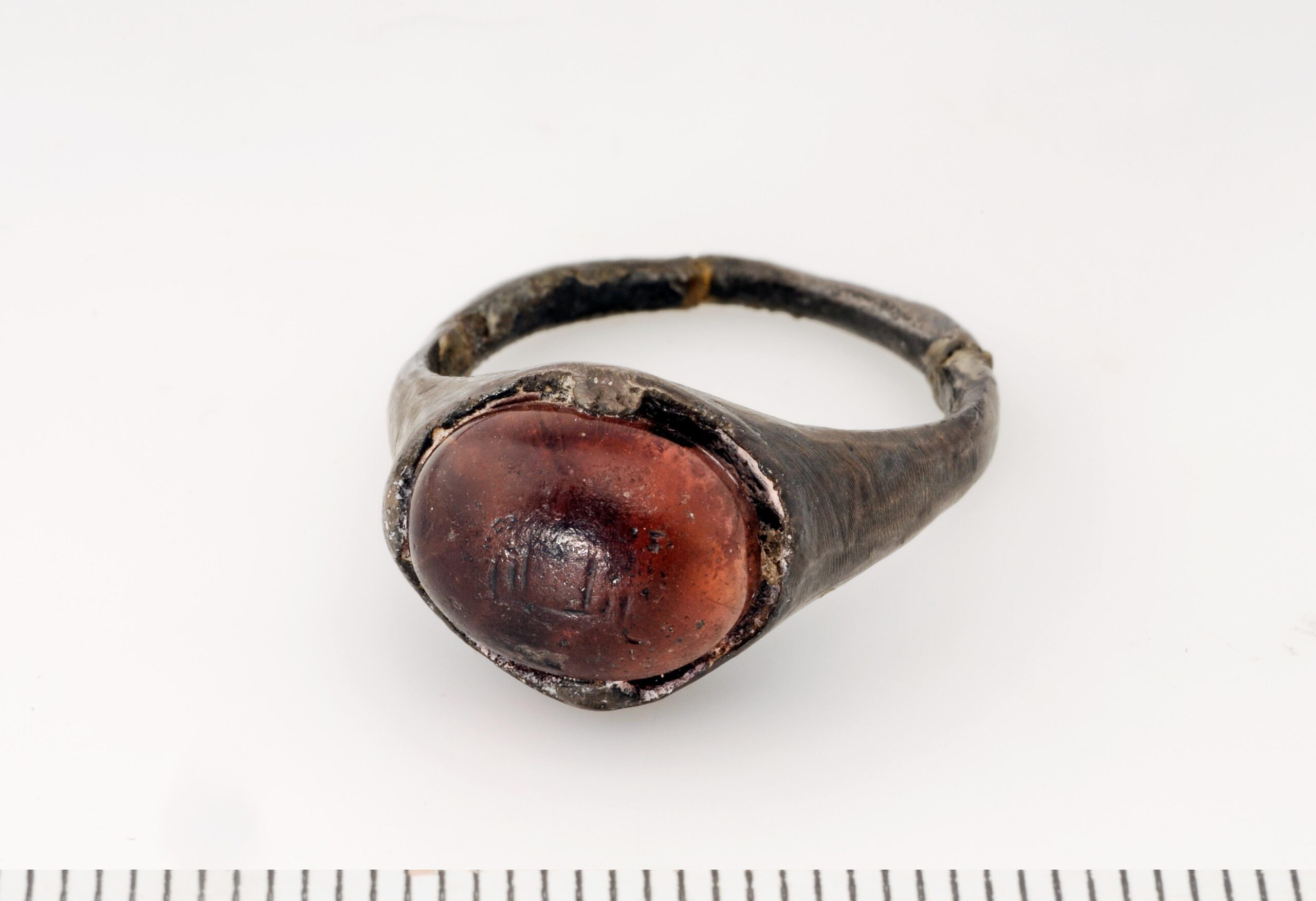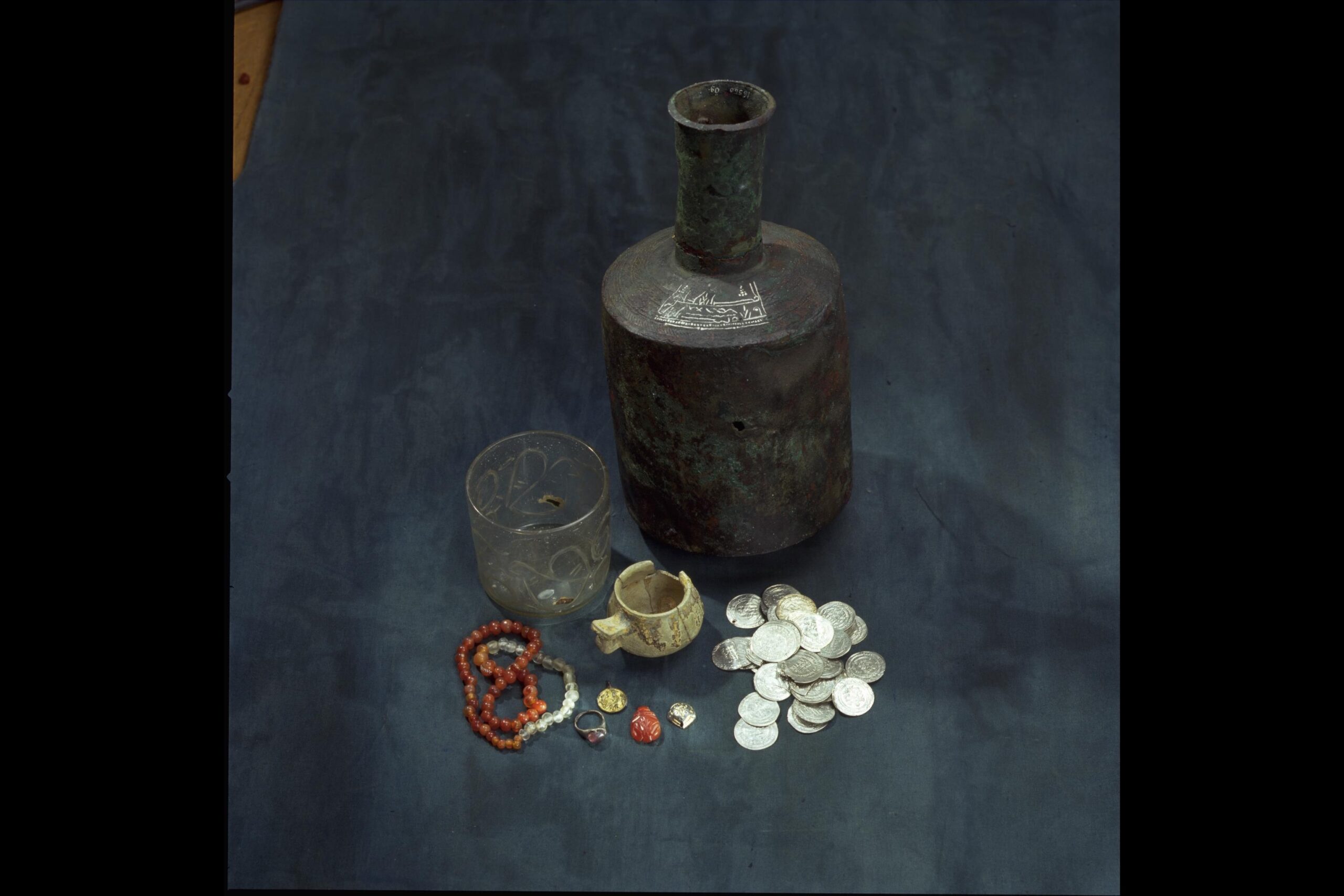One Viking artifact that was widely discussed in popular news sites, ranging from the Washington Post to CNN, was a ring found in Birka, a hotspot for a wide variety of archaeological discoveries from the Viking Age, in modern-day Sweden. What’s fascinating about this ring, made of a high-quality silver alloy, was found to contain a prominent stone containing a type of Arabic script known as Kufic inscribed in it presumably stating something similar to the words “For/to God.” Arabic rings found in the graves of people believed to be Vikings have been found previously but never before within Scandinavia, usually instead being found in Eastern Europe where trade with Central Asia was geographically easier and, therefore, more extensive. This ring was found in the grave of a Viking woman buried in the ninth century CE and was presumably deposited with her.

Finger ring from Bj. 515.
Silver and inscribed glass.
2.6×1.9 cm.
(source: SHM)
This is a high-quality ring. As the Wärmländer and colleagues note, the metal within which the stone is set is made of a very high-grade silver alloy.1 The stone itself within which the Arabic is inscribed, previously believed to be an amethyst, has been determined to be colored glass, although the origin of the glass’s violet coloring remains unknown. Overall, the ring is in relatively good condition, hinting at the fact that the ring had few owners, if any, between the craftsman and the woman buried alongside it.
Despite the ring’s high quality, there’s a paucity of text on the ring. The ring only has the phrase “For/to God.” Considering the lettering however, transliterated as “ILLLH,” an equally likely, or perhaps even more likely, possibility would be that the ring says “except God.” A more complete phrase of “Inshallah” is also possible if we assume some letters in the middle are missing. In any case, this ring is thus highly unlike the dirhams found throughout many Viking grave sites, which often contain full Qurʾānic verses or segments of them.
The Wärmländer and colleagues further note that one fascinating aspect of this ring is its juxtaposition alongside the traditional Scandinavian clothing worn by the woman in her grave, composed of a dress made of blue wool and undergarments made of flax.
In considering this ring that, at first glance, seems out of place in a Viking grave, I think it would be useful to understand how Viking scholars have understood trade networks between the Viking world and the world outside of it. One of the foremost scholars in this regard, Søren Michael Sindbæk, has proposed not only that the medieval world with which the Vikings interacted was highly globalized, but more specifically that the Viking world was connected to this globalized world through what is called a small-world network, that is, a network of trade centralized around select primate sites.2

Finger ring from Bj. 515.
Silver and inscribed glass.
2.6×1.9 cm.
(source: SHM)
A helpful example in the modern day would be to think of airports. Smaller airports tend to have fewer flights, with the flights they do have reaching not too far out. Instead, the world is largely connected through connecting flights to large, international airports in strategic locations or important global cities, such as JFK in New York or Heathrow in London.
Sindbæk largely utilizes chronicles and literary sources, such as the vita of Anskar who was a missionary who sought to convert the Vikings, in addition to information acquired from modern archaeological investigations of Viking emporia like Hedeby and Ribe to help paint an image of how these cities in their heyday served as linchpins in facilitating trade between Vikings as well as between Vikings and the outside world. The ability of these emporia to have far-extending branches across global trade networks helps to explain the seemingly out-of-place objects in Viking archaeological sites that made their way there from faraway locations.
Sindbæk’s theory of the Viking world as part of a small-world network allows us to establish closer connections between the Viking and Islamic worlds than previously possible. Instead of goods passing from hand-to-hand and thereby gradually making their way across Eurasia from the Islamic world to Scandinavia, we can see that the direct links facilitated by these emporia allowed for goods to be exchanged with fewer hands between them, likely reducing damage and change in the object. We know this was the case in Hedeby, at least. In their article discussing the ring, Wärmländer et al. note that detailed accounts exist of Hedeby from Arabic-speaking travelers such as Yacoub al-Tartushi, suggesting that figures from these disparate parts of the world did visit each other’s home regions directly.

Eastern Artifacts from Birka Graves.
Glass beaker, bronze vessel, ceramic cup, silver coins, rock crystal and carneilan beads, and other small finds.
(source: SHM)
At the same time, Sindbæk’s argument that this globalized network operated through only a few specific emporia raises multiple questions. How aware, then, was the average Viking of the trade involved in bringing goods from the Islamic world or Byzantium? Most people would have likely received the item from someone local who either had been to one of these emporia themselves or traded with someone who had. If we set aside our preconceived notions of Vikings as sailors exploring the world, we come to realize that the Vikings were an agrarian people group much like any other in the medieval world. There were farmers and weavers and blacksmiths, many of whom likely stayed in one village or town their entire life. Would this average Viking, thus, have properly understood an item like the ring with the supplication to God inscribed on it as foreign or Islamic? And if the ring is divorced by its user from its Islamic context, instead being an item purchased, appreciated, and later kept for its aesthetic value, does this continue to be an Islamic ring with an invocation to God? Or does the object develop its own meaning as the purpose and intention behind wearing it shifts between its owners? Put more succinctly, at what point does this Islamic ring become Viking? While many popular news sources discussed the ring after the publication of Wärmländer and colleagues’ article presented its presence as an anomaly, I would argue that for the woman who owned this ring and was later buried with it, it felt as much her own as the “stereotypically Scandinavian” clothing her corpse was clothed in before burial.
1 Sebastian K.T.S. Wärmländer et al., “Analysis and Interpretation of a Unique Arabic Finger Ring from the Viking Age Town of Birka, Sweden: Analysis of an Arabic Finger Ring from Viking Age Birka, Sweden,” Scanning 37, no. 2 (March 2015): 131–37.
2 Søren M. Sindbæk, “The Small World of the Vikings: Networks in Early Medieval Communication and Exchange,” Norwegian Archaeological Review 40, no. 1 (2007): 59–74.
« Previous | Home | Next »